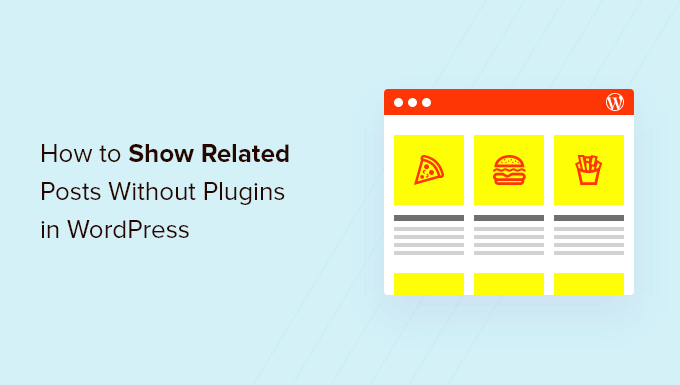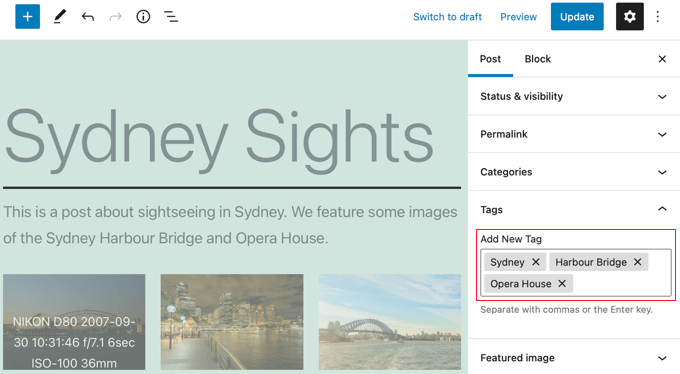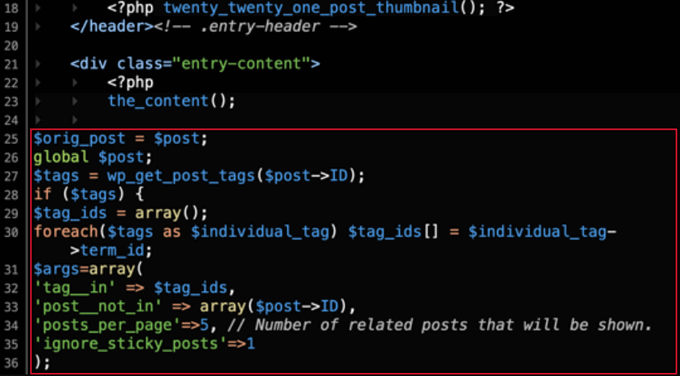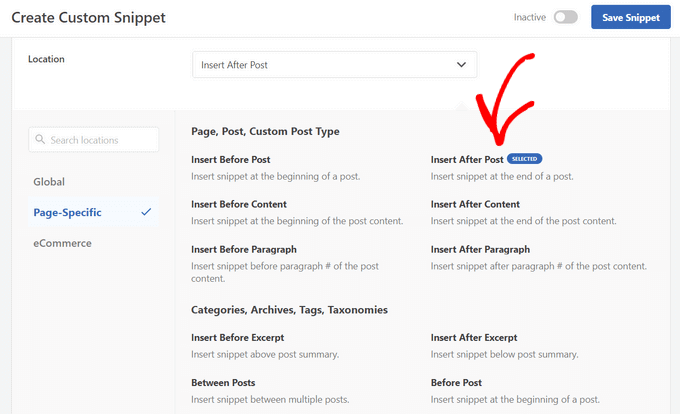Vous souhaitez afficher une liste de publications liées sur votre site WordPress et préférez utiliser du code plutôt qu’une extension ?
Chez WPBeginner, nous soulignons souvent l’importance d’engager votre public et de le faire continuer à explorer votre contenu. Une stratégie efficace que nous avons vu utilisée sur d’innombrables sites WordPress à succès est l’affichage des publications liées.
Lorsque les internautes de votre blog ont terminé la lecture d’un article qui les intéresse, le fait de leur proposer une liste de publications liées les retiendra et les aidera à trouver du nouveau contenu à lire.
Dans cet article, nous allons vous montrer comment afficher des publications similaires avec WordPress à l’aide d’un code, sans aucune extension nécessaire.

Pourquoi afficher les Publications similaires dans WordPress ?
Lorsque votre blog WordPress commence à se développer, il peut devenir plus difficile pour les utilisateurs/utilisatrices de trouver d’autres publications sur le même Sujet.
L’affichage d’une liste de contenus similaires à la fin de chaque publication de blog est un excellent moyen de garder vos internautes sur votre site et d’augmenter le nombre de pages vues. Cela aide également à améliorer la visibilité de vos pages les plus importantes en affichant votre meilleur contenu là où les gens peuvent facilement le trouver.
Si vous n’êtes pas familier avec le code, vous trouverez plus simple de choisir l’une des nombreuses extensions WordPress de publications liées qui permettent d’afficher les publications similaires sans code.
Mais, si vous vous êtes déjà demandé si vous pouviez afficher des publications similaires sans utiliser d’extension, nous allons partager deux algorithmes différents que vous pouvez utiliser pour générer des publications similaires avec des miniatures en utilisant uniquement du code :
Note : Si vous souhaitez afficher une miniature pour chaque publication similaire, assurez-vous d’abord d’ajouter une mise en avant à ces publications.
Méthode 1 : Comment afficher les publications similaires dans WordPress en fonction des identifiés
Un moyen efficace de trouver du contenu similaire consiste à rechercher d’autres publications qui partagent les mêmes identifiants. Les identifiants sont souvent utilisés pour mettre l’accent sur les détails spécifiques contenus dans une publication.
En gardant cela à l’esprit, vous pouvez aller de l’avant et ajouter quelques identifiants communs aux publications que vous souhaitez lier les unes aux autres. Vous pouvez les saisir dans le champ “Tags” de l’éditeur WordPress.

Après avoir ajouté des marqueurs à vos publications, la prochaine chose à faire est d’ajouter l’extrait de code suivant au modèle single.php de votre thème.
Si vous avez besoin d’aide pour ajouter du code à votre site, consultez notre guide sur la manière de coller des extraits de code du web dans WordPress.
1 2 3 4 5 6 7 8 9 10 11 12 13 14 15 16 17 18 19 20 21 22 23 24 25 26 27 28 29 30 31 32 | $orig_post = $post;global $post;$tags = wp_get_post_tags($post->ID);if ($tags) {$tag_ids = array();foreach($tags as $individual_tag) $tag_ids[] = $individual_tag->term_id;$args=array('tag__in' => $tag_ids,'post__not_in' => array($post->ID),'posts_per_page'=>5, // Number of related posts that will be shown.'ignore_sticky_posts'=>1);$my_query = new wp_query( $args );if( $my_query->have_posts() ) { echo '<div id="relatedposts"><h3>Related Posts</h3><ul>'; while( $my_query->have_posts() ) {$my_query->the_post(); ?> <li><div class="relatedthumb"><a href="<?php the_permalink()?>" rel="bookmark" title="<?php the_title(); ?>"><!--?php the_post_thumbnail(); ?--></a></div><div class="relatedcontent"><h3><a href="<?php the_permalink()?>" rel="bookmark" title="<?php the_title(); ?>"><!--?php the_title(); ?--></a></h3><!--?php the_time('M j, Y') ?--></div></li><!--?php }echo '</ul--></ul></div>';}}$post = $orig_post;wp_reset_query(); |
Ce code recherche les identifiants associés à une page, puis exécute une requête dans la base de données pour récupérer les pages présentant des identifiants similaires.
Où devez-vous placer le code ? Cela dépend de votre thème, mais dans la plupart des cas, vous devriez pouvoir coller le code dans le modèle single.php de votre thème, après la publication principale et juste au-dessus de la section des commentaires.
Si vous utilisez le thème Twenty Twenty-One comme nous le faisons sur notre site de démonstration, le bon endroit pour coller le code est dans le fichier template-parts/content/content-single.php après l’en-tête et juste après <?php the_content() ;.

Cela permet d’afficher automatiquement le contenu lié à n’importe quelle publication WordPress. Vous devrez modifier le style et l’apparence de vos publications similaires pour qu’ils correspondent à votre thème en ajoutant du CSS personnalisé.

Astuce: Au lieu de modifier les fichiers de votre thème, ce qui pourrait endommager votre site, nous vous recommandons d’utiliser une extension d’extraits de code comme WPCode.
WPCode permet d’ajouter facilement et en toute sécurité du code personnalisé dans WordPress. De plus, il est livré avec des options d’insertion qui vous permettent d’insérer et d’exécuter automatiquement des extraits à des endroits spécifiques de votre site WordPress, par exemple après une publication.

Pour plus de détails, consultez notre guide sur la façon d’ajouter du code personnalisé dans WordPress. Vous pouvez également consulter notre Avis détaillé sur WPCode pour en savoir plus sur cette extension.
Méthode 2 : Comment afficher les publications similaires dans WordPress par catégorie
Une autre façon d’afficher du contenu similaire consiste à dresser la liste des publications appartenant à la même catégorie. L’avantage de cette méthode est que la liste des publications similaires ne sera presque jamais vide.
Comme pour la méthode 1, vous devez ajouter un extrait de code dans le Modèle single.php de votre thème ou dans une extension d’extraits de code comme WPCode. Pour plus de détails, reportez-vous à la méthode 1 et à notre guide sur la façon d’ajouter du code personnalisé dans WordPress.
1 2 3 4 5 6 7 8 9 10 11 12 13 14 15 16 17 18 19 20 21 22 23 24 25 26 27 28 29 30 | $orig_post = $post;global $post;$categories = get_the_category($post->ID);if ($categories) {$category_ids = array();foreach($categories as $individual_category) $category_ids[] = $individual_category->term_id;$args=array('category__in' => $category_ids,'post__not_in' => array($post->ID),'posts_per_page'=> 2, // Number of related posts that will be shown.'ignore_sticky_posts'=>1);$my_query = new wp_query( $args );if( $my_query->have_posts() ) {echo '<div id="related_posts"><h3>Related Posts</h3><ul>';while( $my_query->have_posts() ) {$my_query->the_post();?> <li><div class="relatedthumb"><a href="<?php the_permalink()?>" rel="bookmark" title="<?php the_title(); ?>"><!--?php the_post_thumbnail(); ?--></a></div><div class="relatedcontent"><h3><a href="<?php the_permalink()?>" rel="bookmark" title="<?php the_title(); ?>"><!--?php the_title(); ?--></a></h3><!--?php the_time('M j, Y') ?--></div></li><!--?php }echo '</ul--></ul></div>';}}$post = $orig_post;wp_reset_query(); |
Vous verrez maintenant une liste de contenus similaires au bas de chaque publication.
Si vous souhaitez modifier le style et l’apparence de vos pages liées, vous devrez ajouter un CSS personnalisé correspondant à votre thème.
Guides d’experts sur les publications similaires dans WordPress
Vous voulez en savoir plus sur l’affichage des publications similaires dans WordPress ? Consultez ces tutoriels utiles sur les publications similaires :
- Comment afficher des Publications similaires dans WordPress (étape par étape)
- Comment afficher les publications similaires d’un même auteur/autrice dans WordPress
- Comment ajouter des publications similaires en ligne dans les articles de blog de WordPress
- Comment afficher des publications aléatoires dans WordPress
- Comment afficher les pages liées dans WordPress
Nous espérons que ce tutoriel vous a aidé à apprendre comment afficher des publications similaires avec des miniatures dans WordPress sans plugins. Vous voudrez peut-être aussi apprendre comment suivre les internautes sur votre site WordPress, ou consulter notre liste de 24 astuces pour accélérer votre site.
Si vous avez aimé cet article, veuillez alors vous abonner à notre chaîne YouTube pour obtenir des tutoriels vidéo sur WordPress. Vous pouvez également nous trouver sur Twitter et Facebook.





imranhunzai
Absolutely awesome! and yeah it helps.
8MEDIA
amazing post ,, thanks
shaileshtr
It is good to show related post in wordpress blog without plugiN. iIt will consume less bandwidth and time to load. http://shareitto.com Thanks for your suggestion.
zioneyemedia
I do have a question on this: I’m wrestling on the code to capture posts from child categories versus parent categories. Any advice?
AmandaLong
This rocks … Thanks!
dustinporchia
I’m trying to use the related posts by category and I noticed that you said the code has to come before the comments in the main loop. In my code I want the related posts to come after the comments in the loop. When I do this I notice my disqus comment plugin takes longer to load now. Is that because of an error with the comments or is that normal?
dustinporchia
Nevermind…I just switched to livefyre as this is more of what I’m looking for in a comment system anyways…thanks!
subzerokh
please
could someone help a newbie like me customize this script so it’ll display related post in an horizontal way?
from left to right..
instead of currently showing it from up to down, vertically…
zioneyemedia
Hey,
How I did it is I replaced the and codes with my own html and css. The codes create lists for each post, and that is usually in a vertical fashion.
——————
<a href="” rel=”bookmark” title=””> <a href="” rel=”bookmark” title=””>
——————
I replaced the opening with and replaced the closing with as my html tags. Then I write my CSS to fit that specific div class needs on your website. For example, a sample pleft class could look like this:
.pleft {float:left; padding:2px; margin:10px; width:278px; height:190px;}
I use the float: selector on my CSS to move posts horizontally, and the margins and padding to give each post spacing within each other. I added in a specific width and height for additional examples.
Hope this helps.
Simos
@zioneyemedia thank you!
gcog
I’ve got related tags for sure, but when I add the code I see nothing. Also, when I add your code to restrict to a custom post type, it gives me an error. I did change the post type to my specific post type.
subzerokh
@wpbeginner hello
thanks for your quick answer…
but i’m a real novice at all you are saying..
can you please give a litlle exemple?
for making them horizontal as on your own blog?
can get in touch by my mail: khiloc at gmail dot com
wpbeginner
@subzerokh You would have to edit the styling. It is not that hard. Simply wrap each post in a div. Specify a width for that div and then set a float left property. Adjust the margins and such and you have it.
subzerokh
hello all!! thanks for this wonderfull script!!
It’s the only thing i found doing exactly what i wanted!!!
But it’s just showing related post in vertical way (from up to down)
I would like it to be shown from left to right (horizontally)
How to do that please??
ConnectIndia
Error Fatal error: Call to undefined function the_post_thumbnail() in /home/connec92/public_html/wp-content/themes/weekly/single.php on line 59 Can some one help. website http://www.connectindia.co.in
xavpro
hey,
great post! maybe you could help me:
i have a auto thumb if none is defined,
if ($thumb_array[‘thumb’] == ”) $thumb_array[‘thumb’] = ‘link to your default thumbnail image’;return $thumb_array;
now my question is how to define a thumb for each category, which will be used if none is defined at post.
dehahs
works nicely, thanks for sharing!
AdnanAsif
Hi
thanks for your great post..
But any change to get posts by categories but not in ul and li and not in thumb..
I mean full posts show in related posts..just like show on home page, with readmore link.
thanks
waiting your reply..
AdnanAsif
Hi
thanks for your great post..
But any change to get posts by categories but not in ul and li and not in thumb..
I mean full posts show in related posts..just like show on home page, with readmore link.
thanks
waiting your reply..
ibadullah25
Can I have a CSS For this please
Editorial Staff
The CSS we used was for a client’s site. You can add your own CSS on how you want to display this.
Admin
titusmagnet
Thanks..im searching for this kinda Code
jaffa
This is great, just what I have been looking for. I wonder though, how could I combine the two above and if there are no tags then it displays posts from the same category?
Trying to figure this out but not getting very far yet
nikbanks
Thanks for the code it worked but how do I style it. I’d like it to be 4 stories side by side like yours. It is listed one on top of another on my site and not listed like yours.
Editorial Staff
That is CSS. We are not using this code to show related stories. Second, i believe what you are talking about is featured stories on our sidebar. We have written another post about that in our site.
Admin
Coolguy
is ther a way to dispay the thumbs in related post without using featured images or post thumbs??
i.e to use any image used in the post …
Editorial Staff
Yes, you can utilize the fallback techniques shared by other developers which pulls the first image from the post. But we recommend using the WordPress post thumbnails…
Admin
Hetal
Thanks for this article. I was wondering if there is a way to auto-tag posts without having to manually enter them.
Editorial Staff
No you have to tag each post manually.
Admin
Sisko
Great!
What if I want to display related posts by category without thumbnails?
Thanks
Editorial Staff
Just remove the thumbnail code from the code above
Admin
Terry
Thank you for posting this tutorial, it helps me a lot.
Adrian
Hi there…Just wanted to say that I’ve been building my wordpress website from the ground up and this code works perfectly for me using WP 3.1….All I need to do now is style the CSS and get some thumbnails happening for the posts. Thanks for your help with the code.
new car release
thanks, i’m looking this hack for so long and you got it to me!
Patricia
Hi, is there a way to exclude categories? I have two main categories where all the categories get assigned to. The main categories have sub-categories and I would like to show just related posts from the sub-categories.
Is this possible, by excluding the id’s of the main categories?
Thanks for your advice!
BTW…love the code…and it works great!!!
Editorial Staff
You should be able to use category not in <<
Admin
usman
I was searching for related post with thumbnails plugins but the code that you paste above, solve my problem.
John
Just one question, is there a way to only pull tags from the same post type? Maybe using something like ‘post_type=videos’?
John
By the way, got this figured out as well:
Just add it to the array:
$args=array(
‘category__in’ => $category_ids,
‘post__not_in’ => array($post->ID),
‘posts_per_page’=> 2, // Number of related posts that will be shown.
‘caller_get_posts’=>1,
‘post_type’=>’videos’
);
marion
Hi,
Thank you for this tutorial. I’m wondering though if there’s anyway the related products can be randomized? I’ve checked different products in the same category and the same related products were shown.
Thanks
Editorial Staff
Yes use the Query_Post parameter for order and you can randomize it.
Admin
Clarence Johnson
Good to know.
phdean
Hi,
I too would like to randomize the posts that display for the categories as, otherwise, they’ll display the same 2 every time. Can you please give me the code to do this?
Many thanks in advance
John
Nevermind, I got it figured out. Thanks for the post!
Editorial Staff
what was the issue?
Admin
John
I didn’t have any other posts with the same tags, i.e. no related posts. Dummy mistake.
John
I copied this code and put it in my single.php without changing a thing and nothing gets outputted. Anything wrong with my code? pastebin.com/kg0SkrAg
James
This doesn’t bring up a thumbnail — there isn’t even a call for an image int eh code. I don’t see how anyone can get this to work.
Editorial Staff
The code for the image is: the_post_thumbnail(); << This is not static html where you will see img src code. The function calls in the database to search for a featured image aka thumbnail that is attached to each article. If found, it will output the image. Now if you do not have post thumbnails enabled in your theme, then you need to add it first:
https://www.wpbeginner.com/wp-themes/how-to-add-post-thumbnails-in-wordpress/
The article clearly stated that in the Note: section. You should consider reading it thoroughly.
Admin
Roberto Silva
hey man, I love your blog!
I have a question?
Can you do the same trick but ” BY Author” ?
showing the latest posts by author?
you will save my life
Btw thanks for this website!
Editorial Staff
Yes we will que the article soon
Admin
Roberto Silva
yessss, thanks…
It will be a great article.
bacause “latest posts by author without plugin” is hard to find on internet.
you are the best.
Quinn
Thanks for this code! I’ve given it a try and it works somewhat.
I can get it to give a listing of the related articles, a huge benefit.
But I can’t seem to get any images to show up.
The articles have images if this code scrapes.
I also went in and created images for each post with the custom tag “relatedthumb”. But alas, still no images.
Is there something else I need to do?
Many thanks in advance!
Quinn
Editorial Staff
This trick is using the default WordPress thumbnails which was added in WP 2.9. If you have an image attached as that thumbnail, then it will pull it.
Admin
Anthony
Is it possible to exclude a category from this module ?
Thanks a lot,
Anthony
Editorial Staff
It will only shows post on the category that the other post resides in…
Admin
Madhav Tripathi
Hi, thanks for this good tutorial, currently I am using Thesis theme, so I want to know if there is a way in thesis theme implement this .php code.
Sophie
I’m trying to modify his code in order to use it with categories within a custom post type. Can anyone help? I’m fairly new to php.
Thanks!
rulethenation
ok i got it to work, is there anyway to put a default pic if a thumbnail is unavailable
Editorial Staff
Yes, you can use the if paramter to check if there are plugins… if not then you can display a default image.
Admin
rulethenation
how would i go about doing that? im a php noob lol
Quickbrown
In order to use default images when no post thumbnail available, replace with <?php if (has_post_thumbnail()) {the_post_thumbnail()} else {echo '’;} ?>
Then put a default-image.jpg under your themes’ image folder.
rulethenation
i cant get this to work, it just messes up my whole layout near the comments, am i missing something? i had to take it off my site
Clarence Johnson
My posts are now enriched thanks to you and this tutorial.
Heather Hill
HI!
Thanks for this information! This is exactly what I was looking for.
Is there a way to add an excerpt to this, along with the photo?
Thanks again for your help!
Editorial Staff
Yes. Just add the_excerpt(); where you want it to display excerpt.
Admin
Jez
Thanks for this, exactly what I was looking for! I love how straight to the point your articles are, no confusion.
Omer Greenwald
Thanks for sharing. I’m using this code for a while now but it has a problem: when adding tags to a post, WP sorts them alphabetically regardless of the priority I added them. So this code displays related posts matching the first tag only which are less relevant sometimes.
Maybe you have an idea how to prevent this auto sorting of tags by WordPress or any other solution?
Editorial Staff
It is not using the first tag. This code is using all tags from the posts to find related posts.
Admin
Clarence Johnson
I’m experiencing the same issue too.
Doug C.
All that first code did was put two instances of the same post on the page. It didn’t show any related anything.
Editorial Staff
Doug please contact us using the form with a live link example, and we can help. We know this code is working because a few of our client’s site is using it.
Admin
Noor
Very use article, thanks for updating
Liam
Great tutorial. Would someone mind showing me a working single.php with this code?
I’m still learning php.
Unfortunately
Parse error: syntax error, unexpected T_ENDIF in C:\xampplite\htdocs\mock\wp-content\themes\scwd\single.php on line 76
Editorial Staff
Here is a working example Flowtown Blog.
Note that this code is so it will work inside the loop. Where are you trying to post this? If it is outside the loop then just add the end if code endif; << like that.
Admin
Liam
http://pastebin.com/m60c96f5f
I hope the link works. Thank you.
Editorial Staff
Don’t know what could be going wrong. After the clearfloat class it should work fine. That is how we put it in flowtown and it is working perfectly.
Liam
I will finish the theme and try it on a live site instead of xamp. I will let you know.
Shahab
Nice tutorial!
Right now i am using YARPP but would love to give this a try!
Thanks
Suriya Kumar P
You guys r really doing a great job. thankz a lot.
Vivek @ InfoEduTech
Thanks for this article. i am searching for lot of time to show the thumbnails with my article i am unable to perform this. i have tried many wordpress plugin but couldn’t done this. hope this might help me out